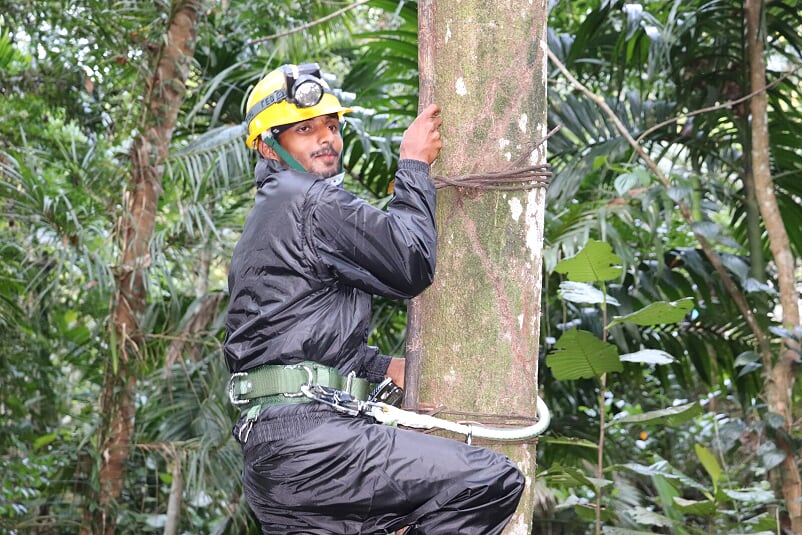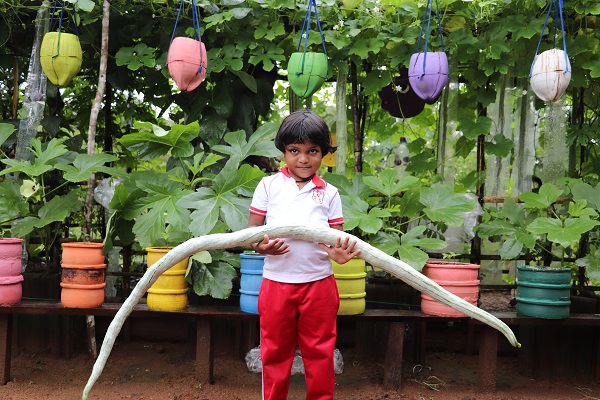Enhancing Climate Adaptation with Nature-based Solutions
Kalutara and Ratnapura districts are flood prone areas in Sri Lanka. During the past decade, about 323,000 flood victims have been reported from these two districts. Floods have disrupted the day-to-day lives and livelihoods of the victims. As a way to improve their lives and livelihoods, in early 2019, the International Labour Organization (ILO) partnered with IUCN, to introduce measures to improve their resilience to floods.

Kithul tapper with safety equipment for tapping
Photo: Dinithi Samarathunga/IUCN
Illukpotha Grama Niladari Division (GND) of Palindanuwara Divisional Secretariat Division (DSD) (in Kalutara), Thannahena GND of Bulathsinhala DSD (in Kalutara) and Wewalkandura GND of Kalawana DSD (in Ratnapura), which have been identified as the most flood prone areas in the two districts, were selected to carry project interventions. The main objective of the interventions was to enhance the resilience of the communities to floods. The main activities carried out during the project included stream bank conservation, introduction of new livelihoods options and improvements to the already existing industries.
As part of the stream bank conservation initiative, the ‘Paravidola’ riverbank was conserved by planting 1,500 kithul plants in a Public-Private-Community partnership. The newly introduced livelihood options included homegardening, beekeeping, poultry farming and mushroom cultivation. For homegardening 40 beneficiaries were selected while for the other activities 10, 16 and 10 community members were selected respectively. A food processing center was also established to minimize post-harvest losses. This is managed by three community members who underwent training in vegetable and fruit dehydration, value addition, labelling and certification etc.
In addition to the above, additional support was extended to improve the already ongoing livelihood activities in the project area such as paddy cultivation, kithul industry and tea planting.
 Snake gourd harvested from a homegarden
Photo: Dinithi Samarathunga/IUCN
Snake gourd harvested from a homegarden
Photo: Dinithi Samarathunga/IUCN
Twenty-five paddy farmers initiated the re-irrigation 25 acres of land with flood tolerant and iron toxic tolerant varieties, promotion of organic cultivation with traditional varieties and establishment of a seed bank with 19 flood tolerant traditional varieties.
The kithul industry, which produces treacle and jaggery is practiced widely in the project area. In order to improve this industry, 32 farmers were selected and provided with training in production of treacle and jaggery and safety equipment for tapping. They were also introduced to scientific methods to maintain the quality of treacle and jaggery.
To promote tea planting, smallholders were educated on soil conservation measures, soil preparation, use of fertilizer for minimum requirement as per the standards etc. A young women entrepreneur was encouraged through the establishment of a tea nursery which practices water efficiency methods such as sprinkler system. Following the training by the Tea Research Institute (TRI) and with the help of Dept. of Agriculture’s Natural Resource Management Centre (NRMC), a demonstration tea plot was also established.
As sustainability measures, two Community Based Organizations were formed for homegardening and kithul farmers and the tea plots were registered for Government led subsidy scheme under the Tea Small Holder Development Authority (TSHDA).
With the newly introduced livelihoods options and improvements to the exiting industries, more than 1,000 villagers are expected to have enhanced resilience to flooding impacts.



